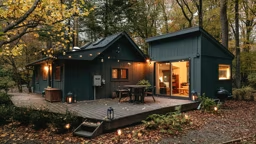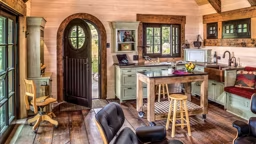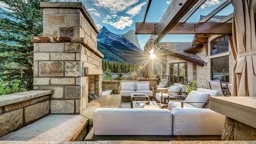Interior designer Lynette Zambon agrees that small homes are gaining in popularity. “What we are starting to see are people moving away from large homes and going for smaller square footage, but with more of a focus on great details. The square-foot price is generally higher because the finishes are nicer.” Zambon shares these interior design tips for small cabins and cottages:
1. Stick to one theme – “It is wise to stick with one theme throughout a home, especially a small house,” says Zambon. “Otherwise, it will feel too busy and you will end up with an identity crisis!” Switching up styles within a cabin can make the space feel chaotic. “We see a lot of projects that have too much going on. Homeowners will come to us and say ‘Help me! What can I do?’ after they have put all of their favorite ideas together in one little space, and it becomes confusing.”
2. Choose quality – Zambon steers her clients towards good quality finishes and furnishings that are going to last and feel timeless. She suggests that cabin owners avoid going for trendy materials that can go out of vogue quickly. The main items to put a lot of thought into are a home’s trim style, wall finishes and flooring. They should be selected with the intention of lasting for the life span of the cabin.
3. Watch the walls – Wall color is an important decision for any cabin, large or small. “Rebbecca Abair (cottage owner, general contractor) did a nice job of choosing white paint for her Sheetrock walls,” says Zambon.
“The warm wood paneling, even though it is left natural, actually absorbs light. Her white walls reflect light, creating a nice balance.” Zambon recommends keeping wall finishes consistent throughout the home. “From that palette you can incorporate additional color into the details, such as trim, or perhaps wallpaper in a bathroom or bedroom.” Decorative tile for backsplashes is also a great way to bring color and detail into a cabin.
1. Stick to one theme – “It is wise to stick with one theme throughout a home, especially a small house,” says Zambon. “Otherwise, it will feel too busy and you will end up with an identity crisis!” Switching up styles within a cabin can make the space feel chaotic. “We see a lot of projects that have too much going on. Homeowners will come to us and say ‘Help me! What can I do?’ after they have put all of their favorite ideas together in one little space, and it becomes confusing.”
2. Choose quality – Zambon steers her clients towards good quality finishes and furnishings that are going to last and feel timeless. She suggests that cabin owners avoid going for trendy materials that can go out of vogue quickly. The main items to put a lot of thought into are a home’s trim style, wall finishes and flooring. They should be selected with the intention of lasting for the life span of the cabin.
3. Watch the walls – Wall color is an important decision for any cabin, large or small. “Rebbecca Abair (cottage owner, general contractor) did a nice job of choosing white paint for her Sheetrock walls,” says Zambon.
“The warm wood paneling, even though it is left natural, actually absorbs light. Her white walls reflect light, creating a nice balance.” Zambon recommends keeping wall finishes consistent throughout the home. “From that palette you can incorporate additional color into the details, such as trim, or perhaps wallpaper in a bathroom or bedroom.” Decorative tile for backsplashes is also a great way to bring color and detail into a cabin.
4. Draw from the outdoors – “I think it is really important to draw from the surroundings for a cabin’s interior color palette,” says Zambon. “Work with the environment, become part of it.” She explains that you don’t have to use the exact colors you see outside, but choose complimentary colors, avoid stark contrast with the outdoor palette.
Plus, it’s important to design with colors that will complement the environment during all seasons. “It’s not uncommon for a designer to come to Montana from New York or Florida, not thoroughly understanding that we have six or seven months of snow outside our windows. And you would not want Florida colors in your Montana cabin!” Zambon says.
5. Light in layers – “Lighting is hugely important to feeling comfortable in your home,” Zambon states.
“I always approach lighting in a layering method,” she says. “Start with the ceiling lights. Particularly in a lofted or cathedral ceiling, it is essential to have the area illuminated rather than feeling like a black hole.” The next layer would be sconces, which are great for creating mood or ambiance. Finally, consider lamps, cabinetry and perhaps even in-floor lighting.
Zambon stresses that lighting should be thoughtfully planned in advance, because it is difficult to remedy in the aftermath of building a cottage. “It’s easy to go wrong, because frequently not enough of the overall construction budget is allocated to lighting. People usually don’t realize that they need a considerable amount for lighting, both inside and on the exterior of a home. It’s one of the things that gets shaved from the budget when cutting costs comes into play.”
6. Pay attention to detail – “If there is one single recommendation I can give,” says Zambon, “it would be stressing the importance of attention to detail.” Detail is what sets a home apart.
7. Accessorize – Furnishings and accessories become primary color accents. “It is easy and inexpensive to change a home’s color palette through accessories like pillows and throws,” remarks Zambon. “It’s surprising what a fresh look can be achieved with a reasonable dollar figure.”
DESIGN RESOURCE: Lynette Zambon, Design Associates, www.dainteriors.com
Click here to read more about the small cottage pictured in the photos above.
Plus, it’s important to design with colors that will complement the environment during all seasons. “It’s not uncommon for a designer to come to Montana from New York or Florida, not thoroughly understanding that we have six or seven months of snow outside our windows. And you would not want Florida colors in your Montana cabin!” Zambon says.
5. Light in layers – “Lighting is hugely important to feeling comfortable in your home,” Zambon states.
“I always approach lighting in a layering method,” she says. “Start with the ceiling lights. Particularly in a lofted or cathedral ceiling, it is essential to have the area illuminated rather than feeling like a black hole.” The next layer would be sconces, which are great for creating mood or ambiance. Finally, consider lamps, cabinetry and perhaps even in-floor lighting.
Zambon stresses that lighting should be thoughtfully planned in advance, because it is difficult to remedy in the aftermath of building a cottage. “It’s easy to go wrong, because frequently not enough of the overall construction budget is allocated to lighting. People usually don’t realize that they need a considerable amount for lighting, both inside and on the exterior of a home. It’s one of the things that gets shaved from the budget when cutting costs comes into play.”
6. Pay attention to detail – “If there is one single recommendation I can give,” says Zambon, “it would be stressing the importance of attention to detail.” Detail is what sets a home apart.
7. Accessorize – Furnishings and accessories become primary color accents. “It is easy and inexpensive to change a home’s color palette through accessories like pillows and throws,” remarks Zambon. “It’s surprising what a fresh look can be achieved with a reasonable dollar figure.”
DESIGN RESOURCE: Lynette Zambon, Design Associates, www.dainteriors.com
Click here to read more about the small cottage pictured in the photos above.

 Roger Wade
Roger Wade 









